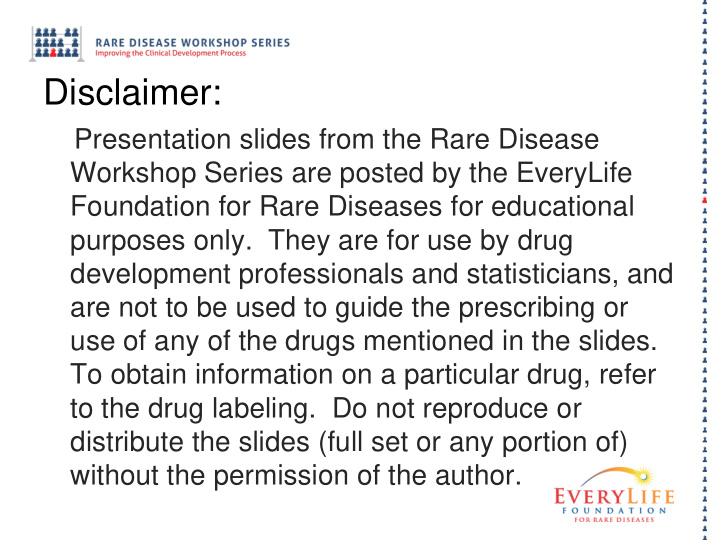



Disclaimer: Presentation slides from the Rare Disease Workshop Series are posted by the EveryLife Foundation for Rare Diseases for educational purposes only. They are for use by drug development professionals and statisticians, and are not to be used to guide the prescribing or use of any of the drugs mentioned in the slides. To obtain information on a particular drug, refer to the drug labeling. Do not reproduce or distribute the slides (full set or any portion of) without the permission of the author.
Rare Disease Workshop 4: Developing Guidance and Policy Recommendation for Accelerated Approval in Rare Diseases November 15, 2012 Larry Bell, M.D. Regulatory, Prosensa
Orphan Drug Act ◦ Signed into law in 1983 ◦ As of September 2010 360 approved products ◦ Approx. 1/3 of NME approvals are Orphan Products ◦ Much more needs to be done More than 6,000 rare diseases affecting more than 25 million Americans, Approx. 200 of these have approved therapies Office of Rare Diseases established in 2010
History of Retroviral approvals ◦ Demonstrates a successful record for use of accelerated approvals and FDA, Sponsor flexibility ◦ AIDS crisis ushered in ‘trial and error’ process of approvals followed by ‘rule making’ Regulations codified in 1992 ◦ Largely in response to AIDS epidemic Since inception of program, of the more than 80 products made available, approx. 40% (32) were to treat HIV
HIV drug approval history has at least two distinctive phases ◦ 1987-1996 (Endpoint studies required for full approval) ◦ 1997-present (HIV-RNA considered validated endpoint) CD4 and viral load, while not perfect, were most promising markers among others (e.g. B 2- microglobulin, cytokines, HIV p24 core antigen) No single marker fully explains varying clinical effects with therapeutic interventions ◦ Use of available markers at the time allowed for earlier access to Rx therapy
CD-4 lymphocyte level in blood is associated with severity of AIDS so change in CD-4 concentration considered as an indicator of disease status ◦ Clinical trials found: slower decline in CD-4 count but no effect on death rate; early rise in CD-4 count but no long- term benefit ◦ CD-4 count positive in several trials in which clinical outcomes positive, and also in several trials where clinical outcomes were not effected ◦ CD-4 counts, while not perfect Allowed earlier access to patients Allowed opportunity to investigate combination therapy and define HART protocol, and evolve knowledge of disease process
Clinical Endpoint studies became increasingly difficult to conduct ◦ Real-time viral load monitoring ◦ With HART, Physicians and Patients unwilling to stay on randomized treatment after viral rebound FDA, NIH, Sponsors worked collaboratively ◦ 1996 Surrogate Marker Working Group ◦ Analyzed large dataset Correlations between viral load and clinical outcome, and viral load suppression and durability of response
1997 Antiviral Advisory Committee conclusions ◦ HIV RNA is a suitable endpoint for: Accelerated Approval (24 weeks) and Regular Approval (48 weeks) ◦ General concordance with other markers, (e.g. CD4) Accelerated Approval process worked well for antiretrovirals ◦ All drugs eventually received regular approval ◦ Viral load is a good surrogate that correlates with disease progression across the spectrum of drugs ◦ Early and late viral load changes are highly correlated
Reasonable Biological model with viable surrogate markers Strong collaborative effort Flexibility on use of available regulations and guidance to meet an unmet medical need Accelerated approval pathway provided for earlier treatment options for patients ◦ Use of available, evolving and best available surrogate markers allowed for knowledge and data to evolve ◦ ‘Trial and Error’ type approach worked well Large extensive database ◦ Useful but not always available in all rare diseases ◦ Need new methodology for linking information from short-term studies Particularly when clinical endpoint studies are not feasible
Capitalize on the successes achieved ◦ Work collaboratively on Accelerated Guidance for Rare Disease Drugs ◦ Advance Regulatory Science, Policies and Decision Making to expedite drug development Better methods for design, conduct and analysis for small trials, and meta-analysis More guidance on emerging science for biomarkers and pharmacogenomics
Work collaboratively to develop a better benefit/risk qualitative framework ◦ Incorporate Analysis of Condition and Unmet Medical need information ◦ Incorporate this information into entire development process Incorporate patient perspective and patient- focused information into drug development ◦ Obtain patient (family as appropriate) perspective on disease severity or unmet medical need ◦ More use when appropriate of PROs
For diseases which are (ultra) rare, serious and/or life-threatening and where there are no alternative options: ◦ There is an urgency to make new medicines available which may require unconventional approaches to development ◦ Global development harmonization is key
Increasingly rare patient populations with different exons skipped Highly variable standards of care further impact ability to recruit patients into trials ◦ Not possible to power study in traditional ways ◦ Need for creative study design ◦ Need to develop novel biomarker and/or surrogate markers ◦ Create risk/benefit framework in context of limited number of patients
Once relationship has been established for surrogate marker (e.g. dystrophin) and clinical outcome ◦ surrogate should be acceptable as primary outcome, placebo should not need to be re-established Groups of exon ‘skippable’ patient populations ◦ overlap enables learning's from one program to another Oligonucleotides have same chemical backbone with predictable pharmacology ◦ enabling learnings across preclinical studies
Concept of extrapolated efficacy Within indication Compound A Compound B Demonstrated safety and Demonstrated safety and efficacy (dystrophin; efficacy (dystrophin; trend 6 mwt, 2 nd functional Comparable efficacy or better 6mwt) outcomes) AMBULANTS AMBULANTS Demonstrated safety and efficacy Compound A Compound A Compound B Compound B Demonstrated safety Demonstrated safety and efficacy and efficacy safety and safety and (dystrophin, 2 nd (dystrophin, 2 nd extrapolated efficacy extrapolated efficacy motor skill functions) motor skill functions) NON-AMBULANTS UNDER 5’S NON-AMBULANTS UNDER 5’S Extrapolated safety and efficacy 14
Recommend
More recommend